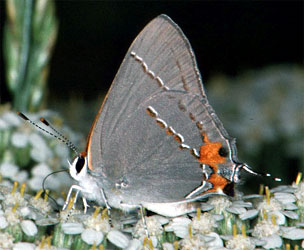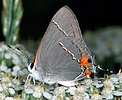Lycaenidae



This tree diagram shows the relationships between several groups of organisms.
The root of the current tree connects the organisms featured in this tree to their containing group and the rest of the Tree of Life. The basal branching point in the tree represents the ancestor of the other groups in the tree. This ancestor diversified over time into several descendent subgroups, which are represented as internal nodes and terminal taxa to the right.

You can click on the root to travel down the Tree of Life all the way to the root of all Life, and you can click on the names of descendent subgroups to travel up the Tree of Life all the way to individual species.
For more information on ToL tree formatting, please see Interpreting the Tree or Classification. To learn more about phylogenetic trees, please visit our Phylogenetic Biology pages.
close boxIntroduction
The Lycaenidae as construed here includes the blues, coppers and hairstreaks, but not the metalmarks, which are viewed as a sister-family Riodinidae, based on the combined phylogenetic analysis of morphological and molecular data by Wahlberg et al. (2005).
Discussion of Phylogenetic Relationships
The higher classification of Lycaenidae is currently in flux. The subfamilies, tribes and subtribes enumerated herein are those listed by Eliot (1973, 1992 [in Corbet et al.]), but the monophyly and implied relationships among these must be viewed as tentative, pending revelations from the large amount of molecular evidence that is currently being gathered by Naomi Pierce and colleagues. The relationships among the four subfamilies are those inferred by Wahlberg et al. (2005).
References
Ackery, P. R., R. de Jong, and R. I. Vane-Wright. 1999. The butterflies: Hedyloidea, Hesperioidea, and Papilionoidea. Pages 264-300 in: Lepidoptera: Moths and Butterflies. 1. Evolution, Systematics, and Biogeography. Handbook of Zoology Vol. IV, Part 35. N. P. Kristensen, ed. De Gruyter, Berlin and New York.
Corbet A. S., Pendlebury H. M., and Eliot J. N. 1992. The butterflies of the Malay Peninsula. Malayan Nature Society, Kuala Lumpur.
Eliot J. N. 1973. The higher classification of the Lycaenidae (Lepidoptera): a tentative arrangement. Bull. Br. Mus. Nat. Hist. (Ent.) 28: 371-505, 6 pls.
Wahlberg N, Braby MF, Brower AVZ, de Jong R, Lee M-M, Nylin S, Pierce NE, Sperling FAH, Vila R, Warren AD, and Zakharov E. 2005. Synergistic effects of combining morphological and molecular data in resolving the phylogeny of butterflies and skippers. Proc. R. Soc. Lond. B 272: 1577-1586.
Title Illustrations

| Scientific Name | Strymon melinus (Lycaeninae) |
|---|---|
| Comments | Cotton square borer |
| Acknowledgements | Courtesy InsectImages.org (#1226716) |
| Specimen Condition | Live Specimen |
| Copyright | © Jerry A. Payne, USDA ARS |
About This Page
Correspondence regarding this page should be directed to Andrew V. Z. Brower at
Page copyright © 2007
Citing this page:
Brower, Andrew V. Z. and Maddison, David R. 2007. Lycaenidae . Version 01 April 2007 (under construction). http://tolweb.org/Lycaenidae/12175/2007.04.01 in The Tree of Life Web Project, http://tolweb.org/







 Go to quick links
Go to quick search
Go to navigation for this section of the ToL site
Go to detailed links for the ToL site
Go to quick links
Go to quick search
Go to navigation for this section of the ToL site
Go to detailed links for the ToL site